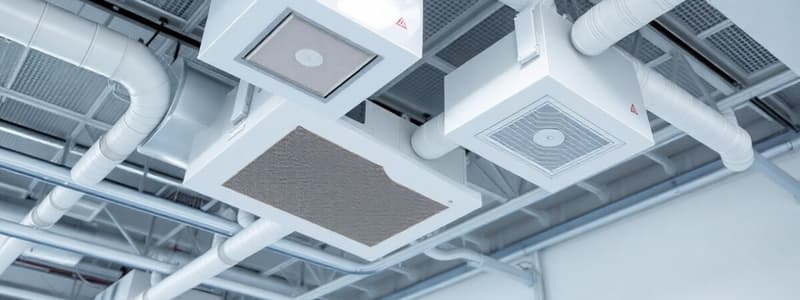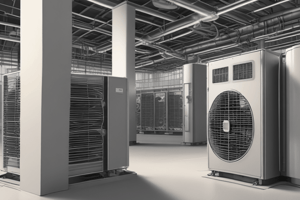Podcast
Questions and Answers
Which of the following describes a manometer?
Which of the following describes a manometer?
- A device used to measure the specific humidity of air.
- A device used to measure pressure in ducts, including static, velocity and total air pressure. (correct)
- A device used to measure the temperature of air.
- A device used to measure the amount of space occupied by 1 lb of air.
The term 'velocity pressure' refers to:
The term 'velocity pressure' refers to:
- The pressure measured at a specific point in the duct.
- The pressure resulting from the movement of air. (correct)
- The total pressure of air in a duct.
- The pressure exerted by air due to its weight.
What is the relationship between total pressure, static pressure, and velocity pressure?
What is the relationship between total pressure, static pressure, and velocity pressure?
- There is no direct relationship between the three pressures.
- Static pressure is the sum of total pressure and velocity pressure.
- Velocity pressure is the sum of total pressure and static pressure.
- Total pressure is the sum of static pressure and velocity pressure. (correct)
Which of the following is used to measure the pressure drop across filter banks?
Which of the following is used to measure the pressure drop across filter banks?
What is the primary function of an anemometer?
What is the primary function of an anemometer?
What does the dew point temperature indicate?
What does the dew point temperature indicate?
What does 'specific humidity' refer to?
What does 'specific humidity' refer to?
Which of the following best describes the concept of 'enthalpy'?
Which of the following best describes the concept of 'enthalpy'?
What is the primary purpose of most air-conditioning systems?
What is the primary purpose of most air-conditioning systems?
Which of the following factors contributes to poor air distribution and discomfort in an occupied zone?
Which of the following factors contributes to poor air distribution and discomfort in an occupied zone?
What is the primary difference between primary air and secondary air in an air distribution system?
What is the primary difference between primary air and secondary air in an air distribution system?
What type of pressure is exerted against the walls of ductwork in all directions?
What type of pressure is exerted against the walls of ductwork in all directions?
What is the primary cause of friction in air ductwork?
What is the primary cause of friction in air ductwork?
What is the relationship between static pressure, velocity pressure, and total pressure in an air distribution system?
What is the relationship between static pressure, velocity pressure, and total pressure in an air distribution system?
What is stratification in an air distribution system?
What is stratification in an air distribution system?
Which of the following is NOT a component of a typical air distribution system?
Which of the following is NOT a component of a typical air distribution system?
What is the main concern regarding air stratification in the occupied zone?
What is the main concern regarding air stratification in the occupied zone?
What is the air called before it undergoes conditioning?
What is the air called before it undergoes conditioning?
What is the most common concern related to drafts in an indoor environment?
What is the most common concern related to drafts in an indoor environment?
What are the ideal temperatures for the occupied zone when heating and cooling from above?
What are the ideal temperatures for the occupied zone when heating and cooling from above?
What is the recommended temperature difference between head and foot levels for a seated person, according to ASHRAE Standard 55?
What is the recommended temperature difference between head and foot levels for a seated person, according to ASHRAE Standard 55?
How does high humidity impact human comfort?
How does high humidity impact human comfort?
What is the primary reason for emphasizing low noise levels from HVAC equipment?
What is the primary reason for emphasizing low noise levels from HVAC equipment?
How does the placement of supply and return air outlets impact ventilation effectiveness?
How does the placement of supply and return air outlets impact ventilation effectiveness?
What is the formula to calculate the area of a duct in square feet?
What is the formula to calculate the area of a duct in square feet?
If the velocity pressure is 0.09 inches water column, what will be the calculated air velocity for a 15” round duct?
If the velocity pressure is 0.09 inches water column, what will be the calculated air velocity for a 15” round duct?
What is the correct calculation for the CFM (Cubic Feet per Minute) when the area is 2 square feet and the velocity is 981 FPM?
What is the correct calculation for the CFM (Cubic Feet per Minute) when the area is 2 square feet and the velocity is 981 FPM?
What principle explains why hot air rises and cold air falls?
What principle explains why hot air rises and cold air falls?
When calculating the area of a round duct with a diameter of 15 inches, what radius should be used in the area formula?
When calculating the area of a round duct with a diameter of 15 inches, what radius should be used in the area formula?
What is the volume of air (CFM) for a 24” by 12” supply duct with a velocity of 981 FPM?
What is the volume of air (CFM) for a 24” by 12” supply duct with a velocity of 981 FPM?
Which of the following describes the occupied zone in a space?
Which of the following describes the occupied zone in a space?
What formula is used to calculate velocity based on velocity pressure?
What formula is used to calculate velocity based on velocity pressure?
Flashcards
Static Pressure
Static Pressure
The pressure exerted against the walls of the ductwork in all directions.
Velocity Pressure
Velocity Pressure
The pressure generated by the velocity and weight of air moving through the ductwork.
Total Pressure
Total Pressure
The sum of static pressure and velocity pressure.
Ductwork Resistance
Ductwork Resistance
Signup and view all the flashcards
Primary Air
Primary Air
Signup and view all the flashcards
Secondary Air
Secondary Air
Signup and view all the flashcards
Stratification
Stratification
Signup and view all the flashcards
Occupied Zone
Occupied Zone
Signup and view all the flashcards
Air Velocity
Air Velocity
Signup and view all the flashcards
Airflow (CFM)
Airflow (CFM)
Signup and view all the flashcards
Duct Area
Duct Area
Signup and view all the flashcards
Velocity Formula
Velocity Formula
Signup and view all the flashcards
CFM Formula
CFM Formula
Signup and view all the flashcards
Pitot Tube
Pitot Tube
Signup and view all the flashcards
Velocity Pressure (Pv)
Velocity Pressure (Pv)
Signup and view all the flashcards
Static Pressure (Ps)
Static Pressure (Ps)
Signup and view all the flashcards
Total Pressure (Pt)
Total Pressure (Pt)
Signup and view all the flashcards
Specific Humidity
Specific Humidity
Signup and view all the flashcards
Manometer
Manometer
Signup and view all the flashcards
Dew Point Temperature
Dew Point Temperature
Signup and view all the flashcards
Anemometer or Velocity Meter
Anemometer or Velocity Meter
Signup and view all the flashcards
Magnehelic Gauge
Magnehelic Gauge
Signup and view all the flashcards
Air Stratification
Air Stratification
Signup and view all the flashcards
Drafts
Drafts
Signup and view all the flashcards
Temperature Stratification
Temperature Stratification
Signup and view all the flashcards
ASHRAE Standard 55
ASHRAE Standard 55
Signup and view all the flashcards
ASHRAE Standard 55
ASHRAE Standard 55
Signup and view all the flashcards
Filtration
Filtration
Signup and view all the flashcards
Study Notes
HRAC-223: Air Conditioning & Distribution Systems
- Course: Air Conditioning & Distribution Systems
- Course Code: HRAC-223
- School: Engineering Technology & Applied Science (SETAS)
- Week: 3
- Topic: Air Distribution Systems
Learning Objectives
- Characteristics of Air:
- Air Distribution
- Air properties
- Air measurements
- Occupied Zone:
- Elements of design:
- Primary Air
- Secondary Air
- Stratification
- Elements of design:
- Comfort in the Occupied Zone
Air Distribution
- The aim of most air conditioning systems is to create a comfortable and high-quality indoor environment.
- A good air distribution system ensures a consistent temperature and airflow in the occupied zone, within acceptable limits.
- Insufficient ventilation, poor distribution, and improper airflow patterns can lead to stuffiness, discomfort, and drafts.
Resistance Pressure
- Air moving through ductwork faces resistance, primarily friction.
- Air movement is not linear; it's turbulent and mixes.
- Different duct materials (metal, fiberglass, flexible) have varying friction characteristics.
- Duct fittings (elbows, tees, reducers) increase resistance, requiring higher pressure or velocity for adequate airflow.
System Pressures
- Duct systems rely on three pressure types to function:
- Static pressure: the pressure exerted by air against duct walls.
- Velocity pressure: the pressure generated by the speed and weight of the air.
- Total pressure: the overall pressure needed to push air through the ductwork.
- Pt = Pv + Ps
Static Pressure
- Static pressure is the pressure exerted by air against all duct walls.
- It's both positive (+) and negative (-).
Velocity Pressure
- Velocity pressure describes pressure in the direction of airflow.
- It represents the pushing force of the moving air.
Total Pressure
- The total pressure required to move air through ductwork is the sum of velocity pressure and static pressure.
Air Properties
- Dry Bulb Temperature: The measured temperature of the air (in °F or °C).
- Dew Point Temperature: The temperature at which moisture condenses from the air.
- Relative Humidity: The percentage of water vapor in the air compared to the maximum vapor the air can hold at that temperature.
- Specific Humidity: The mass of water vapor per unit mass of air.
- Enthalpy: The heat content of the air (in BTU/lb).
- Wet Bulb Temperature: The temperature of air accounting for moisture content.
- **Specific Volume:**Cubic feet of space occupied by one pound of air.
Air Measuring Devices
- Manometers: Used to measure static, velocity, and total pressures in ducts. Also used to measure pressure drops across filter banks to indicate when replacement is needed. Types include U-tube, inclined tube, pitot tube.
- Magnehelic: Measures positive, negative, and differential pressures, similar to a manometer.
- Anemometer/Velocity Meter: Measures air velocity in feet per minute (FPM). Designed for fast response to changing air flow conditions.
Air Measurements
-
Rectangular Duct:
- CFM = Area (SQ. FT) x Velocity (FPM)
- Area = Length x Width / 144
- Velocity = 4005 x Square Root of Velocity Pressure (FPM)
-
Round Duct:
- CFM = Area (SQ. FT) x Velocity (FPM)
- Area = π x Radius² / 144
- Velocity = 4005 x Square Root of Velocity Pressure (FPM)
Air Measurement Calculations (Example)
- Calculations for CFM and velocity using known dimensions and manometer measurements (example provided)
Rules of Airflow
- Hot air rises, while cold air falls (Newton's gravitational observation).
- Free jets of air (unconstrained) generally behave independently from the source.
Occupied Zone
- The region normally occupied by people in a space typically from 6 feet above the floor, more than 3.3 feet from exterior walls or HVAC equipment, and 1 foot from internal walls.
Elements of Design
-
Primary Air: Air that needs conditioning
-
Secondary Air: Conditioned air
-
Stratification: The tendency of air streams to remain separated; generally, maintaining warmer air above the occupied zone is preferred in heating, and cooling requires that warmer air is below the occupied zone.
-
Outlets Placement: Strategically placing supply and return air vents (avoiding short-circuiting) improves ventilation efficiency.
Comfort in the Occupied Zone
- Drafts: Uncomfortable air movement from air currents caused by cold surfaces (e.g., windows).
- Filtration/Air Quality: Uncomfortable feeling due to extreme temperatures (too hot or too cold) or odors/stale air.
- Noise: Low noise coming from fans and ductwork is desirable.
- Temperature: Comfort is the absence of discomfort.
- Humidity: High humidity can cause condensation problems and affect human heat loss while lower is preferable.
- Stratification Controlling stratification is essential to occupant comfort. ASHRAE standards define acceptable temperature differences between a seated and standing person.
Studying That Suits You
Use AI to generate personalized quizzes and flashcards to suit your learning preferences.




